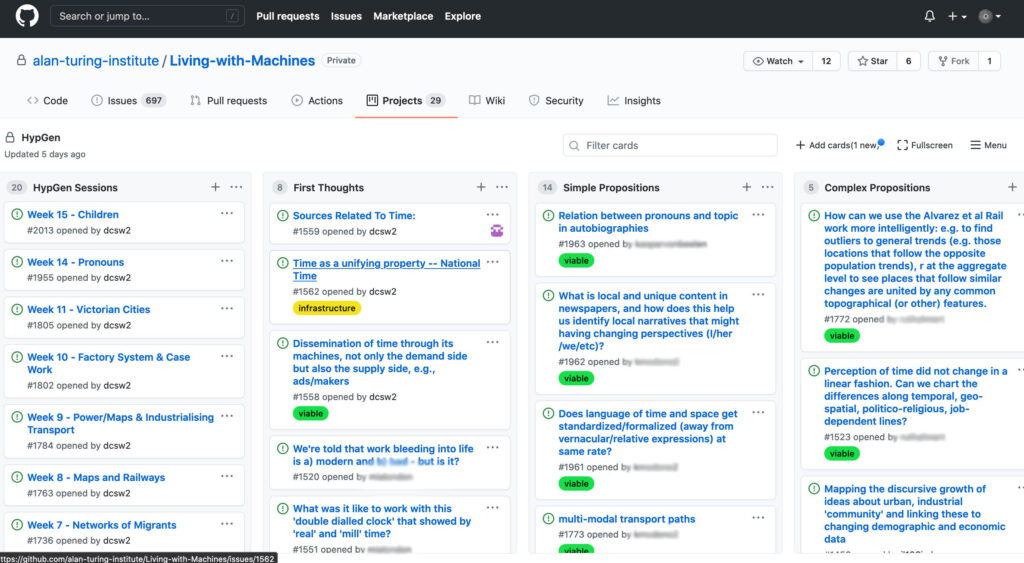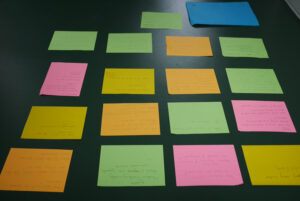Historical Hypothesis Generation (‘HypGen’)
Historians usually come up with a question they want to answer by themselves, so how can a multi-disciplinary team of twenty do the same?
The process of designing historical research is often mysterious, but usually involves certain questions coming together in a historian’s head: what do people already know about this, and what don’t we know? Did any historians say something about this I obviously disagree with? Can I take a proposition contained in an article and turn it into a hypothesis that’s worth testing? If so, what sources would I need? What sources can I get? (Are any archives even open?) Once I get some material, what method will I use to extract the information I want? What framework will I use for reading and interpreting the evidence and making my argument? And most importantly: why do we care?
To approach an answer to these questions is hard enough for an individual, but historians are notorious for being unable to agree with each other about anything. Working in a team containing at least four trained historians (depending how you measure it) as well as a dozen other researchers from different humanistic and scientific fields, plus a sprinkling of librarians and curators, poses an interesting challenge.
Rather than trying speak with one voice, our approach to this challenge has been to embrace the different perspectives available to us in a way that reaps fresh benefits. To do this, we created an experimental space within the project for all members of the team to engage directly with historical materials and the existing debates around them. Our aim was to approach these materials from a new perspective, in order to identify historical propositions for us to test. This became known as the Hypothesis Generation Group, or ‘HypGen’ and has become an important focal point for our work. HypGen is a space for researchers to explore specific ideas which span the existing historiography, but which could be amenable to a data science approach. This resembles what anthropologists (following Peter Galison) have labelled a ‘trading zone’ of methods and concepts, more characteristic of multi-disciplinary projects in the natural sciences.
When collaborating across disciplines, the process of formulating hypotheses needs to be unpacked with each step made explicit, in order to communicate across our zones. Being more explicit about our procedure allows each step to be considered as a point of inquiry for others. When a data scientist reads a work of history, they often respond to it in creative ways that are different to those of a trained historian. They may want to understand the bases of certain assumptions that historians are unaccustomed to examining. Our aim has been to capture such insights, not only for the practical reason of binding our research to what is technically possible, but also to create and generate whole new questions.
Take a historical area of interest such as the rise of the Victorian railway network, or of urban industrialisation as seen on historical maps. A data scientist’s first question may be motivated by her familiarity with the affordances of geo-spatial software learnt in the field of seismology. They may guide our inquiry away from avenues that could prove impossible, based on experience of what visual signals a neural network is likely (or unlikely) to be able to detect on a map. ‘Do you actually need to count those squares? Those thick lines [that you had been ignoring] could be a good proxy for density’; and so forth, are the kinds of conversations we have, and are where the rubber of multidisciplinarity hits the road of research.
HypGen began as a fortnightly exercise in reading and responding. We read classic works of history from the 1950s, as well as some cutting-edge work in digital history; we looked at excerpts from primary sources and explored some online datasets to which we hoped to get access. A historian would introduce the material and ask everybody to respond by attempting to extract a historical proposition that we might test. This rather instrumental approach to reading historical research was a different experience for all involved and put even experienced historians into a different relation to often well-known texts. To begin with, we used the time-honoured practice of using post-it notes to record ideas informally which were then visually clustered together into themes to gauge areas of potential.
After a first edit of these ideas, participants were invited to refine their initial responses into one of several categories: ‘first thoughts’, ‘simple propositions’ and ‘complex propositions’. In the time honoured fashion of a data science project, these were then turned into ‘tickets’ on a GitHub board – an organisational technique common among software developers – which allows an easier assessment of thematic synergies, to assess who would like to pursue which question, and to determine our priorities for further investigation.

It is too soon to form a complete judgement on how this process has shaped our research questions. However, certain conclusions can be drawn: HypGen has proven to be an essential opportunity for a shared immersion into what is for many people a new topic of research. Data scientists, linguists, and even historians from different national backgrounds brought together as a team are unlikely to have the shared cultural wellspring that many British-based academics take for granted, from ‘Luddism’ to ‘Satanic Mills’ and ‘Railway Time’. At the very least we have attempted to create a stronger sense of shared endeavour through which all researchers will have a first-hand sense of the historical problematic into which we are intervening. The serendipitous effects of such acculturation are impossible to assess in their downstream effects, but we hope they will be considerable.
The effect on the historians has, conversely, been to impose a certain discipline by forcing a rigorous attention to questions which can only be tackled at scale. Even historians with a quantitative training are required to look afresh at their methods, their assumptions and their interpretations when working with sources numbering in the tens or hundreds of thousands and so there can be no business as usual.
And finally, it has been very clear that throughout the project, in all sorts of ongoing discussions – intellectual, practical and also strategic – people frequently refer back to a given ‘episode’ of HypGen at which certain ideas were raised. Despite its experimental nature, HypGen has had the effect of providing an anchor point for considering our ideas in relation to the existing literature and the founding aims of the project.
This salutary process of reflection must be undertaken by all researchers, but is one which is easy to overlook, delay and defer by individuals working alone. Working in a large team forces this process into the open, but it takes effort and an investment of time to create the space for such engaged reflection. And yet, this investment can easily be lost or jettisoned when working in a large team facing multiple pressures; and even more so when that large team switches entirely to remote working.
Our project is in the fortunate position of having committed time and resources to these ongoing explorations. At the time of writing, HypGen is entering its third phase as we redesign the process again to account for the way our project as a whole now shifts into its middle period and ideas and simple propositions turn into worked-out research projects, results and outputs.

